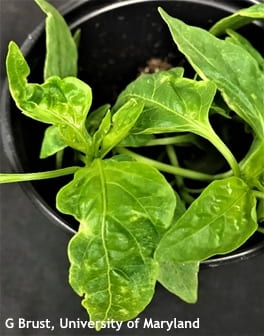Jerry Brust, IPM Vegetable Specialist, University of Maryland; jbrust@umd.edu
Because of the bright sunny days we have had in the past 3-4 weeks, as well as higher temperatures lately, vegetables in high tunnels (HT) are highly susceptible to thrips and two spotted spider mite infestations because of the hot dry conditions. Peppers are a favorite of thrips as they will feed on the tender developing new leaves and this feeding causes the leaves to have a slight yellowing appearance and become deformed and puckered over time as the leaves expand (Fig. 1). This damage can appear as possible virus infections such as tomato spotted wilt, which some thrips (usually western flower thrips) are capable of transmitting. But infection with the virus causes a more mottled overall-distorted appearance of the foliage (Fig. 2). Growers can monitor for thrips using yellow sticky cards that are placed at the same height as the peppers and checking them 2-3 times a week. Early detection can mean using horticultural oils for thrips control rather than relying on synthetic chemicals such as methomyl, tolfenpyrad, spirotetramat or cyclaniliprole in HTs. Be sure you know how your state regulates pesticide use in HTs.
Figure 1. Thrips feeding damage on pepper
Figure 2. Pepper plant with TSWV


